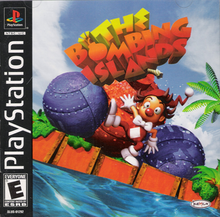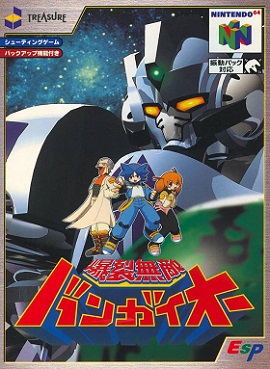
Bangai-O is a multidirectional shooter developed by Treasure and released in 1999 on the Nintendo 64 in Japan. It was ported to the Dreamcast worldwide shortly after with some gameplay changes and updated graphics and audio. The game places the player in control of a weaponized mech that can hover across large stages and fire at enemies all around them. The player must reach the end of each stage and defeat the boss, while avoiding hazards scattered across the map such as enemy mechs and gun turrets.

Vigilante 8: 2nd Offense is a vehicular combat game developed by Luxoflux and published by Activision for PlayStation, Dreamcast and Nintendo 64. It is the sequel to Vigilante 8.
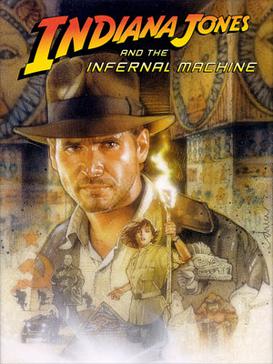
Indiana Jones and the Infernal Machine is an action-adventure video game by LucasArts released in 1999. The first 3D installment in the series, its gameplay focuses on solving puzzles, fighting enemies, and completing various platforming sections. The story is set in 1947, after the events of Indiana Jones and the Iron Phoenix, and puts the eponymous protagonist, the adventurer Indiana Jones, against the Soviet Union. In a race for a mythological Babylonian power source, he joins forces with the Central Intelligence Agency and collects four pieces of the Infernal Machine, an ancient device that allegedly opens a portal to another dimension.

Top Gear Rally is a 1997 racing video game developed by Boss Game Studios and released for the Nintendo 64. A follow-up to Kemco's original Top Gear game, it features a championship mode where a single player must complete six seasons of two to four races, as well as a multiplayer mode where two players may compete against each other via a split-screen display. The game's tracks combine both road and off-road surfaces and can be played in different weather conditions, including night, fog, rain, and snow. Players may customize their car with different tire grips and adjust its suspension stiffness and steering sensitivity. An option that allows players to custom paint their cars is also included.

Fighting Force is a 1997 3D beat 'em up developed by Core Design and published by Eidos. It was released for PlayStation, Microsoft Windows, and Nintendo 64. Announced shortly after Core became a star developer through the critical and commercial success of Tomb Raider, Fighting Force was highly anticipated but met with mixed reviews.

BattleTanx: Global Assault is an action game developed and published by The 3DO Company for the Nintendo 64 and PlayStation, in which players control futuristic tanks in a post-apocalyptic scenario. It is a sequel to the Nintendo 64 game BattleTanx, which utilized the same method of game play. Although it earned relatively positive reviews from critics, 3DO went bankrupt before another sequel could be released.

Madden NFL 2000 is a football video game. This was the second of the Madden NFL games to not solely feature John Madden on the cover in North America. The only other one was Madden NFL '95. Most versions of the game cover featured Madden prominently in the foreground, and a recognizable Barry Sanders in a background action graphic. The European PAL edition features only Dorsey Levens on the cover.

NBA Live 99 is the fifth installment of the NBA Live video games series. The cover features Antoine Walker of the Boston Celtics. The game was developed by EA Sports and released on November 4, 1998, for the Nintendo 64, and then on November 10, 1998, for the Windows and PlayStation. Don Poier is the play-by-play announcer. It was the first NBA Live game released for Nintendo 64. NBA Live 99 was followed by NBA Live 2000.

S.C.A.R.S. is a 1998 sci-fi themed futuristic racing video game developed by Vivid Image and published by Ubi Soft for PlayStation, Nintendo 64, and Microsoft Windows.

Earthworm Jim 3D is a 1999 platform game developed by VIS Interactive and published by Interplay Entertainment for the Nintendo 64. It is the third in the Earthworm Jim series and a sequel to Earthworm Jim 2. It was the first game in the series to not be developed by Shiny Entertainment, which had recently instituted a strict "no sequels" policy. Interplay Entertainment, having recently purchased the Earthworm Jim rights, handed the franchise off to VIS Interactive.

WWF Attitude is a professional wrestling video game based on the World Wrestling Federation released by Acclaim Entertainment in 1999 for the PlayStation and Nintendo 64. A slightly enhanced port of the game was later released for the Dreamcast, as well as a handheld version for the Game Boy Color. The game is named after the WWF's then-current "Attitude" marketing campaign, with the tagline "Get it" also being used on company programming during that period.

Kid Klown in Night Mayor World is a platform video game for the NES published by Kemco on April 1, 1993 and was the first game in the Kid Klown series. It was a reskin of Mickey Mouse III: Yume Fuusen, a licensed platform video game starring Mickey Mouse that was only released in Japan. Released as part of the Crazy Castle series, Mickey Mouse III was released on September 30, 1992 by Kemco in Japan for the Family Computer.
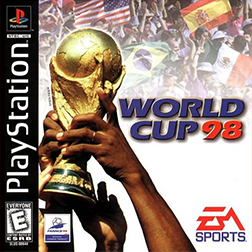
World Cup 98 is a football video game released in 1998 to coincide with that year's FIFA World Cup football tournament, developed by EA Canada and published by Electronic Arts under their EA Sports label. It is the first official FIFA World Cup game developed by EA Sports after obtaining the rights from FIFA in 1997. Unlike the previous World Cup games, which were in 2D and showed a bird's-eye view, World Cup 98 used a 3D engine, utilising DirectX for the PC version.

Armorines: Project S.W.A.R.M., known as Armorines in Europe, is a 1999 first-person shooter developed by Acclaim Studios London and released for the Nintendo 64, Game Boy Color and PlayStation. It is based on the Armorines comic book from Valiant Comics, which was bought by Acclaim Entertainment.

Magical Tetris Challenge is a 1998 puzzle video game by Capcom for the arcade, Nintendo 64, Game Boy Color, and PlayStation. It is a version of Tetris featuring Disney characters. It is one of the few Nintendo 64 games to be entirely in 2D, in addition to being Capcom's first game for the console.

Twisted Edge Extreme Snowboarding, released as Twisted Edge Snowboarding in Europe, is a snowboarding video game released for the Nintendo 64, published by Midway in North America and by Kemco in Japan and Europe. It was released in Japan as King Hill 64: Extreme Snowboarding. Twisted Edge Extreme Snowboarding was not very well received commercially or critically.
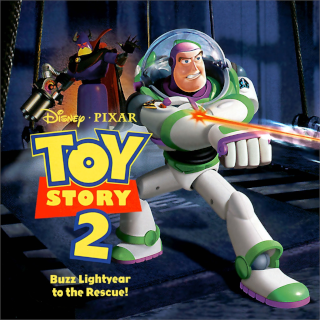
Toy Story 2: Buzz Lightyear to the Rescue is a 1999 platform game developed by Traveller's Tales and published by Activision and Disney Interactive. Based on Disney/Pixar's 1999 computer animated film Toy Story 2, it was released for the Nintendo 64, PlayStation, Microsoft Windows, and Macintosh in late 1999, while a Dreamcast version followed in 2000. The computer versions were released under the title Disney/Pixar's Action Game, Toy Story 2. A different version, a side-scrolling platform game titled Toy Story 2, was also released for the Game Boy Color in 1999.
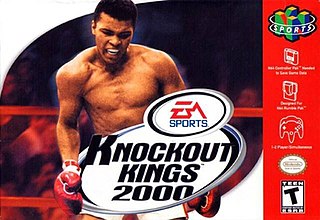
Knockout Kings 2000 is a video game developed by Black Ops Entertainment and published by EA Sports for Nintendo 64, PlayStation, and Game Boy Color in 1999.
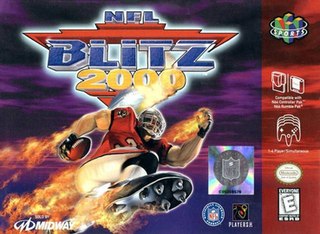
NFL Blitz 2000 is a video game released in the arcades in 1999 and then ported to the PlayStation, Nintendo 64, Dreamcast, Windows, and Game Boy Color. It is the third game in the NFL Blitz series.

NFL Blitz is an American football video game developed and published by Midway for the arcade in 1997, the first game in the NFL Blitz series. The development team was headed by Mark Turmell and Sal Divita, who were known for being behind NBA Jam, and NFL Blitz was a deliberate attempt to translate the exaggerated arcade-style approach of NBA Jam to the football realm. The game was ported to the PlayStation, Nintendo 64, Windows, and Game Boy Color in 1998. The cover athlete for the game was then Pittsburgh Steelers quarterback Kordell Stewart.
